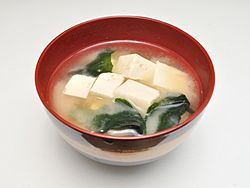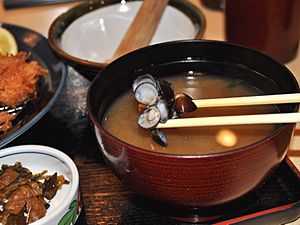Miso soup facts for kids

|
|
| Type | Soup |
|---|---|
| Place of origin | Japan |
| Serving temperature | Hot |
| Main ingredients | Dashi stock, miso paste |
| Similar dishes | Doenjang-guk, doenjang-jjigae |
Miso soup (味噌汁, misoshiru) is a classic Japanese soup. It's made by mixing a special paste called miso into a broth called dashi. You can add many other things like vegetables, tofu, or fried tofu. What's added often depends on the season, where you are in Japan, or just what someone likes.
In Japan, miso soup is a very common soup served with rice. It's sometimes also called omiotsuke. Miso soup is one of the two main types of soup in Japanese cooking. The other is suimono, which is a clear soup seasoned with soy sauce and salt.
Contents
What is Miso Paste?
The type of miso paste you choose really changes the soup's taste. Miso paste is a traditional Japanese seasoning. It's made by fermenting soybeans with salt and a special fungus called Aspergillus oryzae. Sometimes, rice, barley, or other ingredients are also used.
Miso pastes can be red (akamiso), white (shiromiso), or mixed (awase). There are many kinds, including ones named after regions like Shinshū miso.
How long the miso ferments also affects its flavor. White miso ferments for a shorter time. This gives it a lighter, sweeter taste. Red miso ferments longer, making the soup stronger and deeper in flavor.
More than 80% of all miso made in Japan is used for miso soup. About 75% of Japanese people eat miso soup at least once a day.
The Broth: Dashi
The most common broths, or dashi, for miso soup are made from a few key ingredients. These include niboshi (dried baby sardines), kombu (dried kelp), and katsuobushi (thin shavings of dried and smoked bonito). Sometimes, dried shiitake mushrooms are also used.
You can also combine kombu with katsuobushi or dried shiitake. If you use only kombu and/or shiitake dashi, it makes a great vegetarian soup broth.
When the soup includes shellfish like Asari clams or Shijimi, they add their own flavor. This means you don't need to make a separate dashi broth beforehand.
Outside Japan, some miso soups are made with Western vegetable stock. This stock might include ingredients like green onion, carrot, potato, and daikon radish. Some people even use chicken or Western-style fish stock. However, there's a debate about whether these count as true miso soup.
Other Ingredients You Can Add
In Japan, people choose ingredients based on the seasons. They also pick things that offer different colors, textures, and flavors. For example, green onion and tofu are often put together. One has a strong flavor, and the other is mild.
Ingredients that float, like wakame seaweed, are often combined with things that sink, like potatoes. Other common additions include mushrooms (like nameko or shiitake), taro, different kinds of seaweed, onion, nira, beans, mitsuba, shrimp, fish, clams, and sliced daikon. Almost any Japanese ingredient can be added to some type of miso soup. However, most typical miso soup recipes use only a few extra ingredients besides the dashi and miso.
If pork is added to miso soup, it's called tonjiru. This means "pork soup." Tonjiru is usually eaten for lunch or dinner, not typically for breakfast.
For cold weather, heartier versions might include daikon, deep-fried tofu called abura-age, potatoes, onions, and darker miso. Lighter versions are better for spring or summer. These might have ingredients like cabbage, seri, myoga, or eggplant.
How Miso Soup is Made and Served
Miso soup can be made in different ways. Japanese recipes usually suggest cooking most vegetables in simmering dashi. This includes mushrooms, daikon, carrots, potatoes, tofu, and fish.
The miso paste is mixed separately with some dashi broth. This is done to keep the miso paste from cooking directly. Cooking the miso can change its flavor and reduce the health benefits of its good bacteria. Once the vegetables are cooked, the broth is taken off the heat. Then, the miso mixture is added and stirred in. Any uncooked ingredients are added last, and the soup is served.
In Japan, miso soup and white rice are key parts of a traditional Japanese breakfast. This soup has been loved by everyone, from common people to royalty, for many centuries. The soup is usually served in lacquer bowls with lids. People typically drink the soup directly from the bowl. The solid ingredients are eaten with chopsticks. The lid helps keep the soup hot and flavorful, and it also makes the dish look nicer.
Instant Miso Soup
You can also find instant miso soup in single-serving packets. It often comes as a dry powder or paste. Sometimes, it's even freeze-dried. These usually have dried toppings like wakame seaweed and tofu. They quickly become soup when you add hot water. Instant miso soup is popular in Japanese workplaces. It's as easy to make for lunch as green tea, using the same hot water. You can find instant miso soup in many grocery stores outside Japan. It usually lasts for 3 to 12 months.
Wappani
Wappani (わっぱ煮) is a special miso-soup-based dish. It comes from Awashima island in Niigata, Japan. A cedar flask, called a wappa, is filled with miso soup, fish, and vegetables. Hot rocks are then dropped into the flask to heat it up quickly. These hot rocks stay warm for hours, so you can make a hot meal without needing a fire.
Health Benefits
Studies have shown that eating miso soup can be good for your health. In 2003, researchers in Japan suggested that women who eat three or more bowls of miso soup daily might have a lower risk of breast cancer.
More recent studies in 2020 found that regularly eating miso soup can help lower blood pressure and heart rate. It can also help good bacteria grow in your intestines, which can prevent constipation.
See also
 In Spanish: Sopa de miso para niños
In Spanish: Sopa de miso para niños
Images for kids




